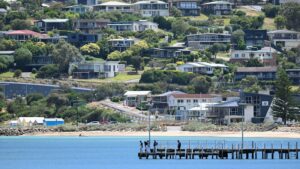
Jack Taylor vividly recalls the day when the air became too hot to breathe. It was early afternoon on a humid Queensland worksite, and the heat was unbearable. “It was 1:30pm — still a couple of hours to go — and the foreman just said ‘bugger this, it can’t be done,'” Taylor recounted. The heat was unlike anything he had ever experienced, prompting him and his partner, Anna Graham, to relocate from the Sunshine Coast to a small community in southern Tasmania last month.
While lower house prices and a change in scenery were appealing, their primary motivation was to escape the relentless heat. “It was quite easy for us to holiday down here and then think to ourselves ‘well, I could quite easily picture myself living in such a beautiful place and I don’t have to work out in the heat year-round,'” Taylor explained.
‘Climate Refugees’ Seek Solace in Tasmania
The phenomenon of Australians moving to Tasmania to escape climate change impacts is growing. The ABC’s callout for stories from individuals who have relocated to Tasmania due to climate concerns yielded numerous responses. Andrew from Launceston moved back after enduring drought and bushfires in Esperance, WA. Ben from Northern Tasmania noted that even in a temperate climate, they are on the frontlines of climate change.
“We moved from SE Qld here for a few reasons but also concerns over rising global heating. A cool, wet temperate climate sounded rational, but even up here in a cold, wet, forested mountain valley we’ve learned in the 7 years we’ve been here that we are well and truly on the frontlines of climate change.” — Ben, Northern Tasmania
Edward from Howrah and Anna from Huonville also shared their experiences of fleeing Queensland’s extreme weather. “The job market in Tasmania is nowhere like the other big cities in Australia. The struggle is real, but life in QLD over the last decade in summer has become unbearable,” Anna stated.
Tasmania’s Vulnerability to Climate Change
Despite its reputation as a climate refuge, Tasmania is not immune to climate change. The National Climate Risk Assessment highlights key hazards for the state, including worsening heatwaves, drought, and flooding. The report indicates that Tasmania, alongside Victoria, South Australia, and southern parts of Western Australia, is likely to experience the highest increases in drought conditions.
“At 3.0 degrees Celsius of warming, heat-related mortality is expected to increase by 146 per cent in Launceston.”
Dr. Karen Palmer, a sea level scientist with the University of Tasmania, emphasized that there’s “no escaping” the impacts of a warming Tasmania. “Closer to the equator, you’re more likely to see those really high temperatures that make it unlivable,” she said. However, Tasmania’s unique ecosystems are vulnerable to even small temperature increases.
Launceston: A Case Study in Climate Risk
Launceston, featured as a key case study in the assessment, is particularly susceptible to ‘compound estuarine flooding.’ This occurs when multiple factors contribute to flooding, such as the North and South Esk rivers combining with storm tides along the kanamaluka/Tamar estuary. The assessment warns that Launceston’s flood risk could result in some areas being submerged by more than two meters of water by 2090.
Erica Deegan, Launceston City Council’s senior asset manager, assured that the council is “well and truly aware” of the potential flooding scenario and prepared to respond when necessary.
Looking Ahead: Balancing Risks and Benefits
Mr. Taylor and Ms. Graham remain confident in their decision to move to Tasmania, despite its climate risks. “Even if those types of issues that we were seeing in Queensland started to eventuate down here, we would probably just be grateful that we would be dealing with a smaller or a lower severity of it,” Taylor said.
The influx of ‘climate refugees’ into Tasmania underscores a broader trend of migration driven by climate change. As more Australians seek refuge from extreme weather, the island state must grapple with its own vulnerabilities and prepare for a future where climate impacts are increasingly unavoidable.







